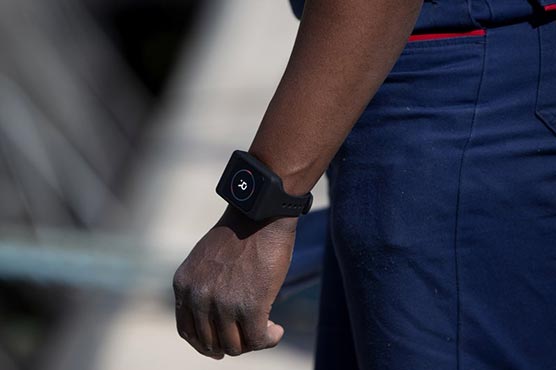Belgian port to test virus bracelets amid tech tracing fears

Belgian port to test virus bracelets amid tech tracing fears
ANTWERP, Belgium (AP) — As the spread of the coronavirus eases and people gradually return to work pondering the impact it might have on their jobs, Europe’s second-biggest port is getting ready to test a device aimed at helping thousands of people employed there to respect social distancing.
At Antwerp in Belgium, where some 900 companies operate in an area the size of a small town, two teams of port workers will be wearing next month a bracelet originally designed to find tugboat crew members that have fallen overboard but now modified to help stop the spread of the disease.
Until a vaccine is found, respecting Europe’s recommended safe distance of 1.5 meters (around five feet), regular hand-washing and the use of masks remain the best methods to defend against any new virus outbreak. So, a mad scramble has begun to develop technologies to prevent its spread.
European countries are designing contact tracing apps for mobile phones to help locate outbreak sources. While they’re a powerful force for good, the various devices are raising concerns about privacy and just how intrusive they might become once they’re in people’s homes or the workplace.
The bracelets are worn like a watch. Coated in black plastic, they vibrate when they move to within three meters (about 10 feet) of each other. The vibration strength, similar to that of a mobile telephone but more obvious when attached to a wrist, increases the closer the bracelets get and warning lights flash.
“You have a helmet, and your safety shoes, and you have swimming vests. All these kinds of things. And now we’re adding a wearable on top of that to make sure that people are safe. And if something goes wrong, that it is being detected as soon as possible,” Antwerp Port Chief Technology Officer Erwin Verstaelen said.
The bracelets ensure physical distancing and collect no data. No plans have been announced at the port to use them to track workers’ movements or measure their performance as some companies elsewhere have explored doing. But they can be programmed to provide information.
“Social distancing and privacy is very important,” said John Baekelmans, CEO of Rombit, the company developing the bracelets. “We do not store any data. There is no communication going out of the bracelets whatsoever. It’s only there to keep people safe.”
In its guidance on the use of mobile phone apps — not bracelets or wristbands — the European Commission says they should be managed by public health authorities and dismantled once they are no longer needed. They should be voluntary, and no one should be punished for refusing to use them.
Ideally, data would be protected by state-of-the-art encryption and only be kept a limited time.
The potential benefits of apps and other devices are easy to see. The virus has killed more than 100,000 people in Europe and Britain, according to the European Centre for Disease Prevention and Control. But experts and trade unions worry that they could become invasive.
Isabelle Schoemann of the European Trade Union Confederation said the organization wasn’t consulted about the testing. She argues that most people don’t need technology to help them understand how far away they should stand from their co-workers.
“We are kind of having a test on a real-life basis, and it is a bit worrying that we are testing that on people, and that we are testing that without having been able to look into what kind of guarantees this technology would bring before the test,” Schoemann told The Associated Press.
Nathalie Smuha, law and ethics researcher and assistant lecturer at the University of Leuven, expressed concern about the unequal power relationship between employers and their staff. She called for a democratic debate on the legal, ethical and political implications of using tracing devices.
“We say that these tools should ideally be used on a voluntary basis,” Smuha told AP. But, she added, “what choice do you have, if otherwise you don’t have a job and you cannot provide for your family?”
Beyond that, Smuha said, people have an inherent bias toward technology that can lead us to think it makes no mistakes. This might incite us to take greater risks, or go further, than we otherwise would.
“Once you start implementing these things it’s very difficult to go back,” she said. “Why only use it on the work floor? Maybe you should also use it on your way to work and back, and maybe you should also use it in a shop in order to have access.”


